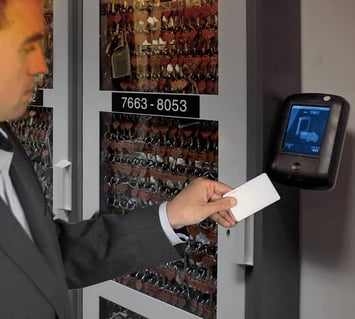By Jay Palter | June 26, 2024
What is a key management system?
K
ey management is the process of securing, tracking, and distributing physical keys within an organization. Why is this important? Since keys grant access to sensitive locations and assets within your organization, improving the security of keys enhances the security of those valuable resources.
Key tracking systems also control the costs associated with using physical keys. These systems reduce overhead through automation. They reduce and often eliminate the need to rekey whole facilities due to key loss or security breaches.
Some smaller companies could employ a pen-and-paper key management protocol. Larger companies, or those wanting better insight and control over keys, usually use electronic key management systems.
- What is a key management system?
- Why use a key management system?
- The components of a digital key management system
- What can you do with a key management system?
- Understand your key management options
- Premium-tier key management systems are electronic
- Don’t just compare hardware, evaluate support services, too
- What process should you follow to buy and install a key management system?
- Key management systems can be the cornerstone of your security program.
Why use a key management system?
An automated key management system is not just a tool, but a cornerstone of your key control process. It offers two key advantages over traditional pen-and-paper systems: Secure storage and distribution of keys, and enhanced key use through automation and analytics. These benefits can significantly improve your organization's security and operational efficiency.
Physical key management systems provide other specific benefits as well, including:
Reduced costs
Electronic key control systems ensure keys are always accounted for. Your staff won’t waste hours hunting down missing keys, so productivity stays high. As a result, key losses will drop, and therefore, so will rekeying costs.
Better risk management
An intelligent key management system maintains a transaction log, so you’ll have an airtight record of who used which keys and when. Your staff will be fully accountable for keys in their possession.
Improved operations
A key control management system affords tighter control over how keys are used in your facility. For example, you can prevent staff from signing out keys on specific shifts, set curfews so keys must be used and returned by a particular time, and allow staff to reserve keys for a specific time slot for time-sensitive tasks.
The components of a digital key management system
Four primary components power a key control system:
1. Key cabinets
Keys are stored in a secure cabinet. These cabinets have an outer locking door to prevent unauthorized access. More advanced key cabinets keep key rings in individual locked slots that only unlock after users authenticate themselves and specify which key ring they want to sign out.
The lock slots are all part of the panel inside the cabinet. You can often select different panel configurations for different sizes and quantities of key rings.

2. Smart terminal
Users must authenticate themselves at an attached smart terminal to unlock the cabinet’s outer door and individual key ring slots. These terminals accept one or more authentication types. For example, Real Time Networks’ key cabinets can accept PIN codes, radio frequency identification (RFID) fobs, swipe cards, smartphone authentication, or biometrics like fingerprints or iris scans.
You can also use smart terminals to present users with checklists they must complete when signing out or returning keys. For example, prompt them to enter the reason for key access if you need to maintain a chain of custody in high-security environments. You can also require drivers to log mileage and maintenance issues when returning fleet keys.

3. Key fobs
In more advanced key tracking systems, your key rings are attached to a tracking fob. Sensors in the cabinet scan the fob when keys are signed out and returned to verify that the correct keys are present.
Smart key management systems provided by Real Time Networks use RFID key fobs. RFID is a short-range wireless communications standard most often used for machine-to-machine communication. You can even embed RFID sensors around your facility to track keys everywhere in real time for high-security tracking.
Learn More:

4. Key management software
Automating your intelligent key management system at the point of the transaction provides a great deal of value. However, when you have access to management software that allows you to monitor and control how your staff uses keys, you can improve the aspects of your business in which those keys are used. Physical keys are transformed into data-generating smart devices that provide data on user behavior and the important workflows within which your keys are used.

What can you do with a key management system?
Intelligent key management is about improving key security and increasing the business intelligence you can generate around how your keys are used. Automating this process with an electronic key management system increases your intelligence-gathering capabilities beyond what human staff members can do by hand and provides many other benefits.
Improve access control
By better-securing keys, you improve your access control over the spaces and equipment that those keys unlock. Better access control is especially important when you permit temporary workers to access those spaces—for example, by giving contracted cleaning crews access to high-security facilities.
You can use your key management to streamline providing temp workers with one-time key access. In addition, the system can log all of their after-hours key access, keeping everyone more accountable.
Enhance your risk management practices
Human error dramatically increases your organization's risk of losing or misplacing keys if you leave your key management entirely up to staff rather than an automated key monitoring system. For example, a supervisor might forget to log a key transaction, or a tired second-shift worker might accidentally bring a critical key home. Small errors can add up, stall important production schedules, and lead to stolen assets or fraud.
The software in a good key tracking system can generate reports on key usage, user access requests, access irregularities, and losses. In addition, you can track and audit key use in real time.
If you’re in a regulated industry, you also may be required to document your key security practices. An electronic key tracker system can quickly generate the access reports you need to demonstrate compliance to regulators.
Prevent key loss
When someone in your organization loses a key, there are direct and indirect costs. Of course, there is the direct replacement cost. But if the lost key was a sub-master or master, you likely need to rekey many locks in your facility.
Those rekeying costs can add up quickly. In addition, losing keys may expose your organization to stiff fines or cost taxpayers if you’re in a regulated or publicly-funded industry.
You are also saddled with the indirect cost of lost productivity. Your staff will spend time searching for lost keys and managing the replacement and rekeying process instead of carrying out their regular duties. If that lost key was your only copy, you may be unable to access critical equipment or vehicles until it is replaced.
Electronic key management solutions make staff more accountable. For example, they automatically generate transaction logs, so you always know who signed out which keys and when. You can even set key curfews so supervisors receive notifications if a staff member doesn’t return a key at the end of a shift or by a custom deadline that you set.
Improve operations
Electronic key control systems expand your options for using keys while giving you tighter control and better insight into how keys are used. For example, you may limit workers in a particular department to accessing specific keys. You can also restrict access by individual workers, time of day, or custom conditions.
You can even allow workers to reserve keys in advance if they need a specialized vehicle or equipment for an important task.
Your staff will also save time tracking down lost or misplaced keys. The automatically generated transaction log will tell you the last known location of every key in the system, making recovery efforts more straightforward. There won’t be any more hunting around your building for an hour only to discover that someone in another department didn’t know a critical key needed to be returned by noon.
Provide better fleet management
Automating your fleet key management provides many benefits. As we’ve already discussed, you can require drivers to log mileage and maintenance issues before they can return keys at the end of a shift. In addition, you can rotate key sign-outs for different vehicles so drivers don’t pick their favorite truck every time.
You can also use a customizable user database to track driver’s licenses and certifications. The system can send supervisors warnings if someone’s license is about to expire so you don’t expose your company to unneeded liability.
Protect your reputation
Better key management helps contain your risk of reputational damage. If word of an expensive or just plain embarrassing key loss gets out, it can steer prospective customers to your competitors in the private sector. Or elsewhere, lead students to think their campus isn’t safe or lead the public to think a police force is sloppy.
Understand your key management options
No two organizations will have the same key management needs. So what makes sense for Company A would be overkill for B, and what is appropriate for B might be dangerously insufficient for A.
Here are some of the different key management technologies you might want to consider for your organization:

Mechanical key cabinets
These secure storage cabinets offer basic security and control over key distribution. However, since they’re mechanical, they do not include automated transaction logging tools. So, any logging you want must be with pen and paper or some other manual means.
Some mechanical cabinets can lock with a master key or other access token. In low-security environments where you only want a basic level of key management, you can simply use unlocked cabinets.
Mechanical key cabinets are suitable for organizations with lower security needs, such as property management companies, car dealerships, or other smaller organizations.

Computer-assisted mechanical key cabinets
These systems are a middle ground between mechanical and electronic key management systems. They usually include simple electronic access controls, such as a PIN-code terminal. They can also sometimes have a built-in computer that records transactions.
PIN codes provide some level of enhanced security. However, since codes can easily be shared, they offer limited value in logging transactions.

Electronic key management systems
Electronic systems offer full automation and electronic control over all key transactions. Thanks to their improved data-collection capabilities, they also provide a higher level of reporting and analytics.
Access control in these systems is usually a more advanced electronic method, such as radio-frequency identification (RFID) tokens or biometrics, like iris eye scans, fingerprint scans, or facial recognition. Computer access control terminals allow operators to include customized features at signout or return. For example, you could include a return checklist that prompts drivers to log mileage and maintenance issues before the management system accepts a vehicle key return.
The Ultimate Guide to Key Control in the Workplace
Learn How to Create a Comprehensive Key Management Policy for Your Organization From Planning to Execution.
Premium-tier key management systems are electronic
Electronic systems are typically used in higher security settings or in organizations that want more insight and control over their keys, such as hotels, gaming venues, large commercial property management firms, or law enforcement agencies. These organizations want real-time insight into who has which keys, where they are, and when users will return those keys.
Software management dashboards
The access terminals in electronic key cabinets can send information management software, usually called the system’s dashboard. Operators can access these dashboards on any authorized PC or mobile device. They can monitor key use in real time, create or modify new user accounts, manage key reservations, and generate reports.

Security integration
You can connect networked key management systems to other security systems for more straightforward, streamlined central management. For example, they can integrate with asset management systems, fleet management modules, and other existing access control systems. All of these systems could share a common user database.

Real-time location services
Key tracking systems that include RFID sensors can provide different levels of location service—meaning they can detect when keyrings are physically present in other locations. When you attach an RFID sensor to a key ring, the electronic cabinet can verify that the correct keys are signed out or returned when a user makes a transaction.
In high-security settings, you can also distribute sensors around your worksite. Those sensors can relay key ring locations to the management dashboard in real time, so supervisors will always know where critical keys are at any given moment.

Don’t just compare hardware, evaluate support services, too
Ensuring you get the right level of key management is essential if you want to see a positive return on investment. This is why it is so important to evaluate your options. But remember, key management systems are more than just the hardware mounted to your wall. Because they’re driven by powerful software and often networked to other security and business systems, they’re a living technology that will require maintenance and support.
When comparing different key systems, make sure you also compare their providers’ service and support options. For example, will they be available to customize the hardware installation to your facility? Can they help develop access control checklists for your workflows? What about generating custom reports for your regulatory needs?
When you ensure that your key management system is well-designed, you ensure your keys and your business are well-protected for years to come.
What process should you follow to buy and install a key management system?
It takes an investment in time upfront, but you’re more likely to get the most cost-effective and efficient key management system if you follow this three-step process:
Start by defining your desired outcomes. Gather stakeholders in your company and decide what you want to accomplish by adding an automated key management system to your company’s operations. Then, set some key performance indicators for what improved management might look like.
You’ll note that in this first step, you’re not even considering different products. You need to identify the business outcomes you want before considering specific technology.
Only after those outcomes are set should you consider what tools you’ll need. First, identify the necessary hardware components. For example, you might need two key cabinets: one for the warehouse and one for your front office.
Then, identify the locations where these systems will need to be installed. For example, your front office key cabinet is next to the security desk, and the warehouse cabinet is next to the time clock. Figure out what will be most efficient in your particular environment.
Then, determine the system configuration. You must decide how many key rings each cabinet will hold, what type of access control you’ll use, and whether you need real-time key tracking throughout your facility.
Finally, evaluate different products on the market and determine which ones fit the needs you’ve identified in the previous two steps. Key management systems are complex technology that needs ongoing support. So, you’ll need to evaluate service and technical support options in addition to the actual hardware and software.
Ideally, you’re looking for a key management service provider who’ll be with you for the system’s entire lifecycle. They’ll be closer to a business partner rather than just a vendor.
Key management systems can be the cornerstone of your security program.
A key management system does more than just secure keys. It protects, manages, and improves entire workflows using those keys. If a workflow includes a key, then there’s a good chance a key management system can improve that work.

See Live How a Smart Key Management System Works
Take Control of Your Keys with KeyTracer's Innovative Tracking System.
Subscribe to our blog

Jay Palter
Vice President of Marketing & Partnerships




